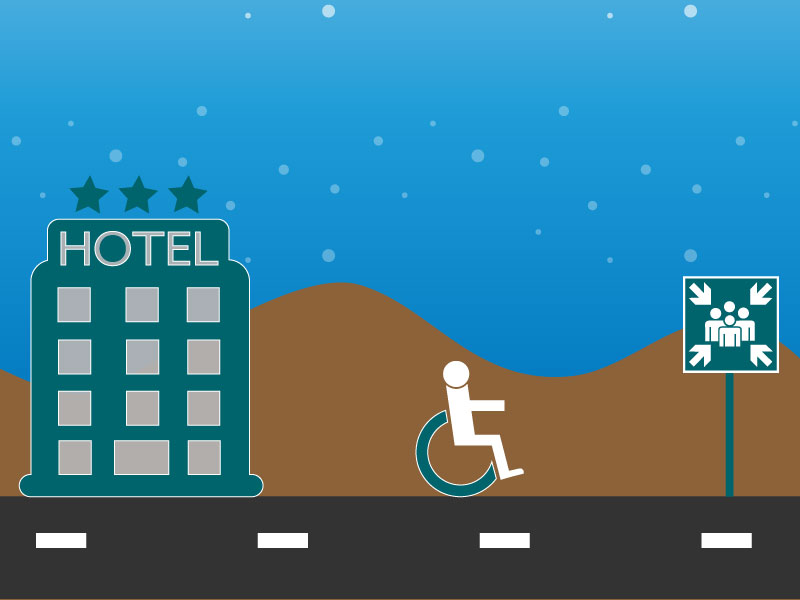Evacuation of disabled persons
06.46
From 2007 to 2010
TML developed the evacuation component of a building evaluation model, based on the NOMAD pedestrian model, to simulate safe and timely evacuations, with a special focus on people with disabilities. This model was applied in a case study for the Holiday Inn hotel in Ghent to identify bottlenecks during evacuations.
The focus on accessibility has increased considerably in Flanders in recent years, and the hospitality industry in particular has always played a pioneering role in this area. For them, disabled and elderly people are an important target group. Accessibility, fire safety, and evacuation are important concerns. In practice, however, it is difficult for an architect or building owner to assess whether a design or a building meets these points. Indeed, such an evaluation requires a lot of specialised knowledge.
In this project, three models were developed that evaluate buildings on the following aspects:
Transport & Mobility Leuven developed the evacuation component. The pedestrian model NOMAD, developed by TU Delft, served as a basis for this. In a pedestrian model, an environment (e.g., a building) is modelled in which simulated pedestrians move around. By carefully defining scenarios, we can use this pedestrian model as a (simple) evacuation model, under certain assumptions regarding the total number of people and the distribution of disabled people throughout the building.
The implementation of different types of pedestrians allows the model to consider different types of disabilities (motor, visual, auditory, cognitive). The monitoring of some characteristics during the simulation allows obtaining an assessment of the building in relation to evacuation. This is communicated to the user through indices, similar in interpretation to the Polis indices.
A case study was carried out for the Holiday Inn hotel in Ghent. The results showed that the main bottleneck during an evacuation is the restaurant exit, where a large number of people try to evacuate through a relatively small door.
The focus on accessibility has increased considerably in Flanders in recent years, and the hospitality industry in particular has always played a pioneering role in this area. For them, disabled and elderly people are an important target group. Accessibility, fire safety, and evacuation are important concerns. In practice, however, it is difficult for an architect or building owner to assess whether a design or a building meets these points. Indeed, such an evaluation requires a lot of specialised knowledge.
In this project, three models were developed that evaluate buildings on the following aspects:
- Accessibility: for this purpose, the Policy model, the result of a European project, was further developed. In the Polis model, the accessibility of a building for people with disabilities is measured using indices. These assign a percentage to each part of the building indicating to what extent it is usable for a person with a specific disability.
- Fire safety: this component of the project examines the extent to which the building complies with (Belgian) legislation on fire safety, focusing on people with disabilities. Again, the evaluation of the building is done using indices that indicate whether the building complies.
- Evacuation: the evacuation component checks whether a building can be evacuated in a safe and timely manner. Evacuation differs from accessibility in the time aspect and the interaction of several people during the evacuation, which requires a different approach from that for accessibility.
Transport & Mobility Leuven developed the evacuation component. The pedestrian model NOMAD, developed by TU Delft, served as a basis for this. In a pedestrian model, an environment (e.g., a building) is modelled in which simulated pedestrians move around. By carefully defining scenarios, we can use this pedestrian model as a (simple) evacuation model, under certain assumptions regarding the total number of people and the distribution of disabled people throughout the building.
The implementation of different types of pedestrians allows the model to consider different types of disabilities (motor, visual, auditory, cognitive). The monitoring of some characteristics during the simulation allows obtaining an assessment of the building in relation to evacuation. This is communicated to the user through indices, similar in interpretation to the Polis indices.
A case study was carried out for the Holiday Inn hotel in Ghent. The results showed that the main bottleneck during an evacuation is the restaurant exit, where a large number of people try to evacuate through a relatively small door.


